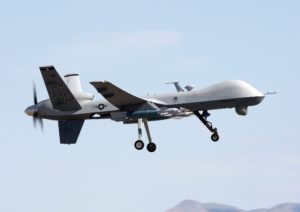 In an impressive move last month, the MQ-9 Reaper unmanned aerial vehicle (UAV) added a new capability to its growing list: the aircraft successfully took off and landed automatically. This new automated feature will help expand the US Air Force’s (USAF’s) mission capability, enhance combat effectiveness and increase flexibility.
In an impressive move last month, the MQ-9 Reaper unmanned aerial vehicle (UAV) added a new capability to its growing list: the aircraft successfully took off and landed automatically. This new automated feature will help expand the US Air Force’s (USAF’s) mission capability, enhance combat effectiveness and increase flexibility.
“Adding this level of automation will reduce the deployment burden of the warfighter and expand the scope of missions that can be flown by Air Force MQ-9s,” said General Atomics Aeronautical Systems President David R. Alexander.
According to Air Force Technology, the MQ-9 Reaper’s automated take-off and landing capabilities also “help expand the operational scope for cross-wind operations, in addition to enabling divert field landing.” Deploying UAVs requires a remarkable level of technical capability and precision even in rugged air terrain. And because of its all-weather functionality, this new automated feature aligns well with the MQ-9’s other features. Take, for example, the UAV’s synthetic aperture radar system. The SAR system is what provides military commanders with the high-res images and footage needed to make mission-critical decisions. The SAR system’s high-resolution capabilities can operate in any weather condition and at any time of day or night. The accuracy of the images and video gathered by the MQ-9 Reaper is partly due to the traveling wave tube amplifier (TWTA), a critical underlying technology onboard the UAV. The TWTA helps power the SAR system and must be able to perform reliably under extremely harsh conditions at 50,000 feet in the air. Without TWTAs, high-resolution SAR images would not be possible.
In fact, the high-power TWTAs used on MQ-9 Reapers are designed and manufactured right here at dB Control, where we consistently develop innovative products with TWT technology. We recently debuted a high-power, wideband, rack-mount TWTA with a 7.5 to 18 GHz frequency range and 4kW Peak power at 6% duty cycle. The dB-3911 TWTA was developed for demanding applications like antenna pattern/radar cross-section measurements, electronic countermeasures and electronic warfare simulation. Through our stringent manufacturing processes and harsh environmental tests, we can ensure our TWTAs will keep up with the expanding capabilities and missions of the MQ-9 Reaper.
Image: A MQ-9 Reaper flies above Creech Air Force Base during a training mission. (U.S. Air Force photo/Paul Ridgeway)


